Elmojo can likely cover the speaker portion of this build with a pair of floorstanding speakers with your current planning. But perhaps your friend may have (or not have) other visions for his entertainment. If you are thinking about left and right stereo speakers plus a sub (a 2.1 arrangement) you might wish to integrate them with a home theater receiver as the center piece of his electronics. He can purchase a five channel (5.1 or 5.2) or more channels receiver (starting price in the mid $200 range) and just use a 2.1 speaker connection. What you add with the receiver is integration of his various music and vision sources (TV, perhaps blu-ray disc player, cable/satellite receiver, digital music via internet or a phone/or small player, etc.) can be integrated together and play though his set of speakers. The receiver would have an crossover output (or 2) for driving a powered subwoofer (or2). As you move upward in the HT receiver options, the receiver offers you additional flexibility (internet connection, room sound correction and equalization, etc.) to have a common location for his entertainment.
With a subwoofer you can choose smaller speakers on stands to flank the TV screen as left and right channels. The sub would typically cover the lower frequency sounds (below say 100 Hz or less) and the smaller speakers run from that crossover point upward.
My downstairs system uses (in a 2.2 arrangement) a 9.2 HT Denon AVR-X3600H receiver with my set of Modified CBT24 arrays as stereo speakers and two subs to cover the lower frequencies. The receiver connects my TV to a cable/satellite receiver, a blu-ray player, a computer for internet music/video sources, and such. I use the receiver's Audyssey room correction capability to adjust the sound to perfection, wirelessly connect from my iPOD (or iPhone) via Air Play 2, connect to the internet from say YouTube (or your choice) music videos and music, Spotify (or your choice) for music streaming, and connect to virtually every radio station within the world via their WWW feed.
A choice for HT receiver info is the Crutchfield website at:
Home Theater Receivers, A/V Receivers, and Surround Sound Receivers
My Modified CBT24 arrays are described in this thread:
My New Line Array--It's a Modified CBT24
For other speaker DIY kits (you build the enclosures) consider offerings from Meniscus Audio at:
Speaker Kits - Meniscus Audio
My point is that there is a lot of possible paths to take down to the end results if you think of this project as a system.
With a subwoofer you can choose smaller speakers on stands to flank the TV screen as left and right channels. The sub would typically cover the lower frequency sounds (below say 100 Hz or less) and the smaller speakers run from that crossover point upward.
My downstairs system uses (in a 2.2 arrangement) a 9.2 HT Denon AVR-X3600H receiver with my set of Modified CBT24 arrays as stereo speakers and two subs to cover the lower frequencies. The receiver connects my TV to a cable/satellite receiver, a blu-ray player, a computer for internet music/video sources, and such. I use the receiver's Audyssey room correction capability to adjust the sound to perfection, wirelessly connect from my iPOD (or iPhone) via Air Play 2, connect to the internet from say YouTube (or your choice) music videos and music, Spotify (or your choice) for music streaming, and connect to virtually every radio station within the world via their WWW feed.
A choice for HT receiver info is the Crutchfield website at:
Home Theater Receivers, A/V Receivers, and Surround Sound Receivers
My Modified CBT24 arrays are described in this thread:
My New Line Array--It's a Modified CBT24
For other speaker DIY kits (you build the enclosures) consider offerings from Meniscus Audio at:
Speaker Kits - Meniscus Audio
My point is that there is a lot of possible paths to take down to the end results if you think of this project as a system.
Last edited:
That's very helpful zman01, thanks!
I find it difficult to keep track of the various generational changes and model feature differences between these drivers.
I find it difficult to keep track of the various generational changes and model feature differences between these drivers.
@Jim: Oh wow, I somehow missed your post!
That's a really good point. He tells me he's not really interested in a HT setup "right away", which means that as soon as we're done and he hears how good it all sounds (hopefully), his next question will be "ok, how do we add surround sound?".
I was thinking almost exactly what you mentioned at the start, about maybe not needing a sub right away, if the floorstanders are capable enough.
He's not a basshead, and mostly listens to classic rock, folk, pop, etc...
Do you think he would be happy with a set of Pensils or your MLTL cabs with either the Alpair 11MS or 10.3 drivers?
I'm leaning towards the 10.3s at the moment, simply because the 11s are out of stock at Madisound, and other places I've looked charge more than I can justify for them.
That's a really good point. He tells me he's not really interested in a HT setup "right away", which means that as soon as we're done and he hears how good it all sounds (hopefully), his next question will be "ok, how do we add surround sound?".
I was thinking almost exactly what you mentioned at the start, about maybe not needing a sub right away, if the floorstanders are capable enough.
He's not a basshead, and mostly listens to classic rock, folk, pop, etc...
Do you think he would be happy with a set of Pensils or your MLTL cabs with either the Alpair 11MS or 10.3 drivers?
I'm leaning towards the 10.3s at the moment, simply because the 11s are out of stock at Madisound, and other places I've looked charge more than I can justify for them.
Elmojo,
If you are ok with the grey cones, they are still available at Madisound:
Markaudio Alpair-11MS Grey Cone 6.5" Full Range
If you are ok with the grey cones, they are still available at Madisound:
Markaudio Alpair-11MS Grey Cone 6.5" Full Range
Elmjo, My Modified CBT24 solution does not need surround speakers as it has more uniform sound coverage within the room. Sound fall off is half of a point source speaker. One of the benefits of a line array.
Thanks zman, I was hoping for the copper cones, but I may compromise to get those drivers.
@Jim: Your line array is absolutely beautiful, but far beyond my ability and budget, sadly.
@Jim: Your line array is absolutely beautiful, but far beyond my ability and budget, sadly.
Elmojo, I hope you have more clarity on the way forward. I am grateful that the big guns (actual designers of these enclosures) started giving advice. Dr Scott’s post in the other thread is most helpful.
My personal opinion is – get that SMSL amp, get the Alpair 10.3 drivers, build the Jim Griffin MLTLs and see what your friend says. He can add a sub or extend to surround sound later. diyAudio is a process and preferences change over time, but just start somewhere like you did already.
My personal opinion is – get that SMSL amp, get the Alpair 10.3 drivers, build the Jim Griffin MLTLs and see what your friend says. He can add a sub or extend to surround sound later. diyAudio is a process and preferences change over time, but just start somewhere like you did already.
twocents has a good plan for a start. My 10.3 MLTL is a reasonable size and will satisfy most all non-basshead listeners.
So Jim mentioned in the other thread about the propriety of using the driver for which an enclosure was designed, which I'm fully behind.
I was looking at the Pensil 11 plans, for the Alpair 11MS drivers of course.
I'm really liking that combo, simply for the easier driver installation, and the simplicity of the enclosure build.
Is there some specific aspect of that driver/cabinet combination that I'm overlooking that would make it unsuitable for my application? I realize that it may not have quite the low end response of Jim's MLTL design. Are we talking about a drastic difference here, to the point that a sub would be considered required, or something that you'd have to have fairly trained ears to discern?
I'm sorry to keep beating this deceased equine, but this is a gift/commission for a good friend, so I want to do the best I can for him within my limited means and abilities.
I was looking at the Pensil 11 plans, for the Alpair 11MS drivers of course.
I'm really liking that combo, simply for the easier driver installation, and the simplicity of the enclosure build.
Is there some specific aspect of that driver/cabinet combination that I'm overlooking that would make it unsuitable for my application? I realize that it may not have quite the low end response of Jim's MLTL design. Are we talking about a drastic difference here, to the point that a sub would be considered required, or something that you'd have to have fairly trained ears to discern?
I'm sorry to keep beating this deceased equine, but this is a gift/commission for a good friend, so I want to do the best I can for him within my limited means and abilities.

The construction part of the project is for you to judge as to what you can achieve and the quality of the woodworking you wish to give to your friend. Mounting the Alpair 10 variants can be done with the aid of a circle router fixture as it needs to be depth mounted to be flush with the baffle surface for best results. Some people have used a supra baffle (a larger oval piece of wood the thickness of the driver flange) which can be through cut to the flange diameter flange) to space around the driver away from the enclosure to mitigate the routed depth cut. A local kitchen cabinet maker can be hired if you need assistance. In reality with some practice with scrap wood will provide you with the skill to succeed.
Now the 11ms driver in Scott's design would be easier to fit to the enclosure because of its thinner flange but routing a bevilled edge would be needed.
Another consideration is the Mark Audio provided SPL vs. frequency plots of the 10.3 M, 10 P, and the 11 MS drivers. Versus the 10 variants the 11 MS has an rough and ugly SPL response across frequency which to me is unacceptable.
The Alpair 10 variants have the ability to go into the 30s Hz region which would be acceptable for your friend's listening. If in the future he develops a need for bass, then only a subwoofer can satisfy that need.
Now the 11ms driver in Scott's design would be easier to fit to the enclosure because of its thinner flange but routing a bevilled edge would be needed.
Another consideration is the Mark Audio provided SPL vs. frequency plots of the 10.3 M, 10 P, and the 11 MS drivers. Versus the 10 variants the 11 MS has an rough and ugly SPL response across frequency which to me is unacceptable.
The Alpair 10 variants have the ability to go into the 30s Hz region which would be acceptable for your friend's listening. If in the future he develops a need for bass, then only a subwoofer can satisfy that need.
Last edited:
All good points, as always Jim, thank you.
I've tried making a circle jig for my router, but it's not working as well as I hoped. If I can avoid having to cut the recesses, that would probably be best.
A supra baffle is certainly an option, which I will look into for sure.
I hadn't realized that the 10-series drivers had "cleaner" response graphs than the 11s. Why would they release a driver with demonstrably 'worse' characteristics? Does it have other redeeming qualities that mitigate the nasty graph, in your opinion? I feel that there has to be some justification for the product's existence, and I would imagine you (or maybe Dave or Chrisb?) would perhaps know what that might be... Inquiring minds want to know! 😀
I've tried making a circle jig for my router, but it's not working as well as I hoped. If I can avoid having to cut the recesses, that would probably be best.
A supra baffle is certainly an option, which I will look into for sure.
I hadn't realized that the 10-series drivers had "cleaner" response graphs than the 11s. Why would they release a driver with demonstrably 'worse' characteristics? Does it have other redeeming qualities that mitigate the nasty graph, in your opinion? I feel that there has to be some justification for the product's existence, and I would imagine you (or maybe Dave or Chrisb?) would perhaps know what that might be... Inquiring minds want to know! 😀
So I took the good advice from Jim, and ordered a pair of the Alpair 10.3's from Madisound. They should be here today, or Monday.
I also agree that Jim's MLTL design is likely to give the best results for my particular use case. The problem is that unless I'm blind (likely), I just can't seem to find any sort of plans or even a sketch of his design. I'm a visual learner. 😀
I do see the text description of the design intent in the first post of his 10.3 MLTL thread. Is that still the latest info? I know these designs tend to morph and evolve over time on occasion, so I figured I'd ask before diving into the build. 🙂
I also agree that Jim's MLTL design is likely to give the best results for my particular use case. The problem is that unless I'm blind (likely), I just can't seem to find any sort of plans or even a sketch of his design. I'm a visual learner. 😀
I do see the text description of the design intent in the first post of his 10.3 MLTL thread. Is that still the latest info? I know these designs tend to morph and evolve over time on occasion, so I figured I'd ask before diving into the build. 🙂
Try this link for my Alpair 10 drawing:
Dr Griffin's MLTL Design - Creative Sound Solutions
Check this thread to discern any changes beyond
the Alpair 10 plan:
Mark Audio Alpair 10.3/A10p MLTL
Read the dimensions in the first post and check vs. the original plan.
Dr Griffin's MLTL Design - Creative Sound Solutions
Check this thread to discern any changes beyond
the Alpair 10 plan:
Mark Audio Alpair 10.3/A10p MLTL
Read the dimensions in the first post and check vs. the original plan.
Last edited:
Excellent, just what I was looking for!
So I've checked local sources, and I can get either 7-ply birch, or 9-ply maple, both in 3/4".
Which would be preferable?
So I've checked local sources, and I can get either 7-ply birch, or 9-ply maple, both in 3/4".
Which would be preferable?
I don't really know. The better quality 3/4" Birch plywoods here have 13 plies (plural of ply?). So, I suspect the more plies the better. Here is a discussion but not a clear verdict (on the Maple):So I've checked local sources, and I can get either 7-ply birch, or 9-ply maple, both in 3/4".
Which would be preferable?
Maple ply?
Judgement of your plywood choices from thousands of miles away is less than precise. More plies would normally be best but your woodworking ability will be on display for years. Hence, a good veneer cover would be remembered forever.
I apologize, I wasn't clear with my question. I meant which was better structurally? That link twocents posted helped. I might go with the 9-ply maple. I'm not really concerned with the looks on either, since I do plan to veneer either one.
Update: finally done
Apologies, I intended to do an update a while ago.
The speakers are finally done! I just put the feet on last night.
I wasn't able to get good quality plywood, and MDF with veneer was going to be cost-prohibitive, so I contracted my local cabinet guy to make the enclosures for me from solid oak. I installed the drivers, ports, terminal cups and applied the finish. The finish is 2 coats of Minwax stain in Golden Pecan, and 2 coats of satin clear Polyurethane, all applied with a spray gun.
I personally would have gone with a darker finish to contrast the driver cone color, but this is what by buddy wanted, to match his living room.
The bottom feet are 1.25" silicone domes from Amazon, "Soundrise" brand, but there are several that are the same thing. They stick well and should provide stable mounting and some vibration isolation on his hardwood floors. Please note that these are not recommended for carpet. They made things less stable, not more.
The sound is good, not what I'd call great. I'm hoping he's happy with them, but I don't think I'd build another set. The cost is far too high for the performance, at least from what I'm experiencing so far. The clarity is pretty nice, but there's very little bass, and I seem to be hearing some distortion at moderately high listening levels. Some of this of course could be from mistakes I made in construction, or maybe I'm just expecting too much from these little drivers. After my stellar experience with the Alpair 5's in my desktop computer speakers, I had higher hopes for these. Oh well, live and learn. 🙂
Thanks to everyone for the advice along the way, I learned a ton, and isn't that the point?
Apologies, I intended to do an update a while ago.
The speakers are finally done! I just put the feet on last night.
I wasn't able to get good quality plywood, and MDF with veneer was going to be cost-prohibitive, so I contracted my local cabinet guy to make the enclosures for me from solid oak. I installed the drivers, ports, terminal cups and applied the finish. The finish is 2 coats of Minwax stain in Golden Pecan, and 2 coats of satin clear Polyurethane, all applied with a spray gun.
I personally would have gone with a darker finish to contrast the driver cone color, but this is what by buddy wanted, to match his living room.
The bottom feet are 1.25" silicone domes from Amazon, "Soundrise" brand, but there are several that are the same thing. They stick well and should provide stable mounting and some vibration isolation on his hardwood floors. Please note that these are not recommended for carpet. They made things less stable, not more.
The sound is good, not what I'd call great. I'm hoping he's happy with them, but I don't think I'd build another set. The cost is far too high for the performance, at least from what I'm experiencing so far. The clarity is pretty nice, but there's very little bass, and I seem to be hearing some distortion at moderately high listening levels. Some of this of course could be from mistakes I made in construction, or maybe I'm just expecting too much from these little drivers. After my stellar experience with the Alpair 5's in my desktop computer speakers, I had higher hopes for these. Oh well, live and learn. 🙂
Thanks to everyone for the advice along the way, I learned a ton, and isn't that the point?
Attachments
-
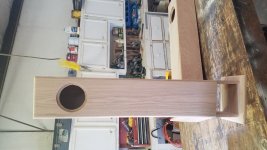 20200822_123125 (Medium).jpg246.8 KB · Views: 115
20200822_123125 (Medium).jpg246.8 KB · Views: 115 -
 20200828_185022 (Medium).jpg368.3 KB · Views: 118
20200828_185022 (Medium).jpg368.3 KB · Views: 118 -
 20200830_152022 (Medium).jpg192.8 KB · Views: 117
20200830_152022 (Medium).jpg192.8 KB · Views: 117 -
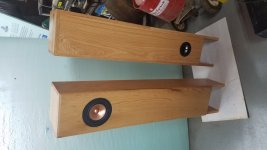 20200830_224418 (Medium).jpg176.9 KB · Views: 122
20200830_224418 (Medium).jpg176.9 KB · Views: 122 -
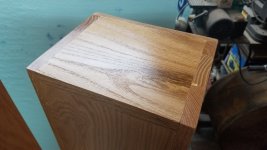 20200830_224456 (Medium).jpg215.1 KB · Views: 113
20200830_224456 (Medium).jpg215.1 KB · Views: 113 -
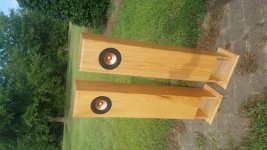 20200831_165900 (Medium).jpg372.3 KB · Views: 97
20200831_165900 (Medium).jpg372.3 KB · Views: 97 -
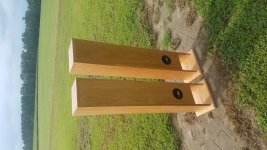 20200831_165928 (Medium).jpg372.8 KB · Views: 85
20200831_165928 (Medium).jpg372.8 KB · Views: 85 -
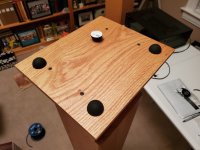 20200908_215833 (Medium).jpg169.8 KB · Views: 83
20200908_215833 (Medium).jpg169.8 KB · Views: 83
A beautiful speaker!
Bass amount depends on room placement and can be improved by addition of baffle step compensation. BSC is often needed if the speaker is placed away from the walls in the listening area. BSC will enhance the bass at the expense of lower sensitivity in the upper mid and treble output areas. But the sound has a better balance across the frequency band.
Also in this case the location of the port tube is important to achieve optimal bass performance. I simulated and optimized performance with the port tube several inches above the bottom of the enclosure--not at the bottom of the box.
If you lengthen the bass tube an inch or two, you can lower the F3 low end point a bit as well.
Bass amount depends on room placement and can be improved by addition of baffle step compensation. BSC is often needed if the speaker is placed away from the walls in the listening area. BSC will enhance the bass at the expense of lower sensitivity in the upper mid and treble output areas. But the sound has a better balance across the frequency band.
Also in this case the location of the port tube is important to achieve optimal bass performance. I simulated and optimized performance with the port tube several inches above the bottom of the enclosure--not at the bottom of the box.
If you lengthen the bass tube an inch or two, you can lower the F3 low end point a bit as well.
Last edited:
- Home
- Loudspeakers
- Full Range
- 2.1 buy or build for a friend?